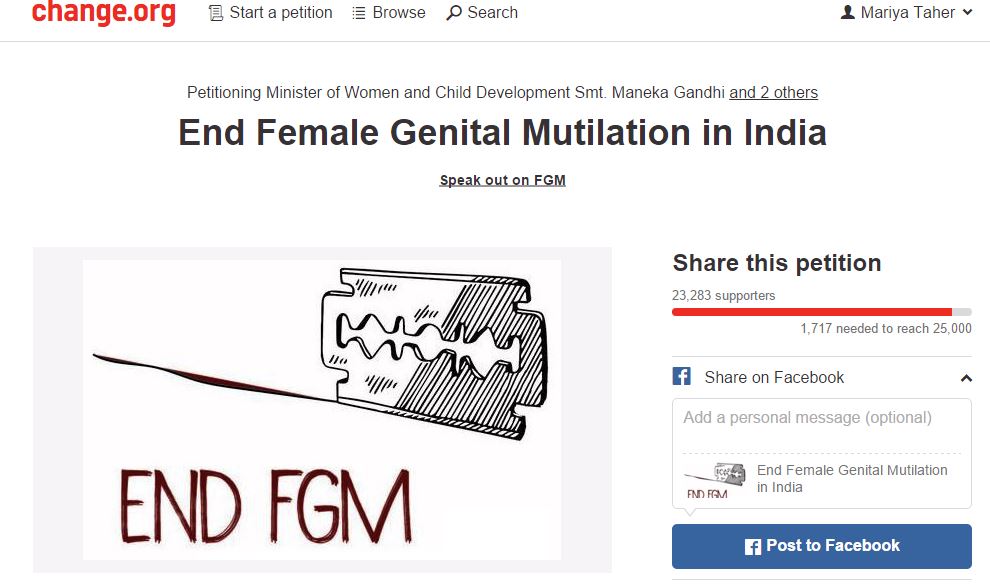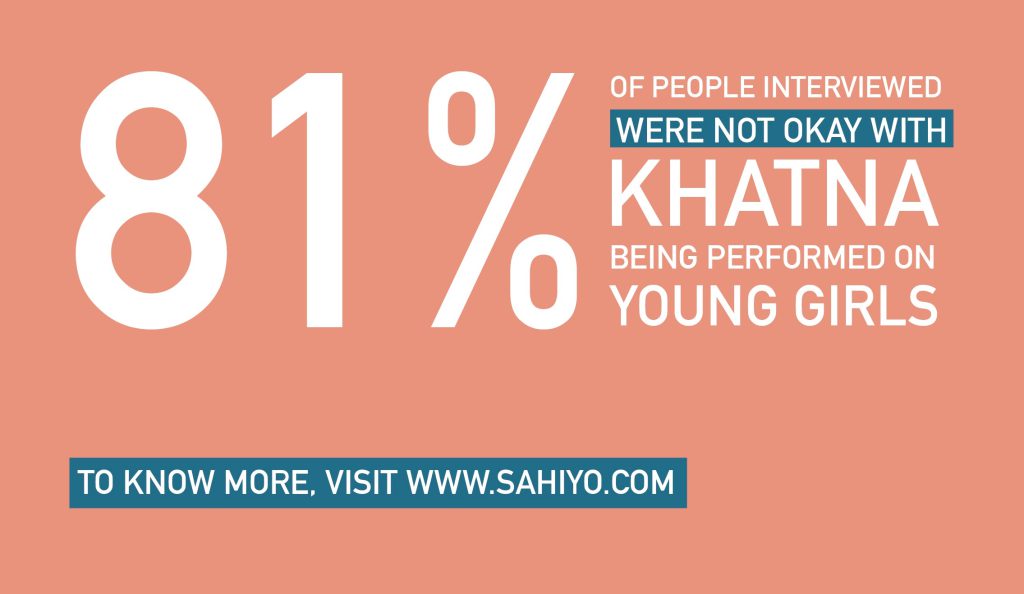SIGN ANTI-FGC PETITION TODAY!

In 2011, an anonymous Bohra woman using the name ‘Tasleem’ made the first attempt to end the practice of female khatna through an online petition on Change.org. That petition was addressed to Syedna Mohammed Burhanuddin and received less than 4,000 signatures. The Bohra community has come a long way since then. On December 1, 2015, Masooma Ranalvi and 16 other Bohra women from around the world launched another petition – this time addressed to various ministers in the Government of India – demanding a law against Female Genital Mutilation as practiced by Bohras in India. This was the first time that such a large number of women from the community decided to discard their anonymity and publicly speak out against a practice that has affected them. The petition managed to get more than 2,000 signatures in the first two days itself, and has garnered more than 23,000 supporters so far. More notably, it has received plenty of attention and support from various media organisations, including Mumbai Mirror, DNA, Huffington Post, Scroll.in, and BBC. To sign the petition now, click here.
FAQs

WHAT IS FEMALE GENITAL CUTTING? Female genital cutting (FGC), or female genital mutilation (FGM), is the practice of removing parts or all of a woman’s external genitalia for various purposes. This could range from cutting the tip of the clitoris to removing the inner and outer labia, and in some communities, stitching the labia nearly closed. There is no standard age at which the practice is performed on girls or women. Some communities cut girls at birth or in early childhood, and other communities wait for puberty or just before a woman’s wedding. Typically, among Dawoodi Bohras, FGC is performed some time between the ages of 6 to 9 years old. The exact origins of the practice are not known, but it is widely believed that FGC originated in Eastern Africa, and predates Christianity. Today, various types of FGC are known to be practiced in over 92 countries globally. FGC is a social norm, and different communities give various cultural, traditional, and religious reasons for the continuation of the practice. However, the overarching theme behind the practice is that it preserves the cultural identity of the group. Various justifications are given for why this preservation is needed, such as to control a woman’s sexuality by reducing her ability to obtain sexual fulfillment, which helps maintain the purity of a woman by keeping her a virgin until marriage, and faithful to her husband once married. A third commonly cited justification for genital cutting by Jews, Christians, Muslims, and other indigenous religions is that genital cutting is a religious requirement. Social pressure by family and friends can also create an environment in which FGC is known as an informal or formal requirement for social acceptance, and/or is a marriageability requirement. Researcher Gerry Mackie suggests that in some communities FGC may have become a marriageability requirement because they view female genitals as offensive to men, and being infibulated is considered more beautiful. These justifications of aesthetics also relate to the notion that female genitals lack cleanliness and must, therefore, be cut. Some communities also claim it is necessary to help girls become complete women. Some also claim it promotes fertility and/or enhances a woman’s sexuality. WHO PRACTICES FEMALE GENITAL CUTTING IN INDIA? Female genital cutting (FGC) in India has been associated with the Dawoodi Bohra community and other smaller Bohra sub-sects, including the Suleimani and Alavi Bohras. However, a 2017 investigation by Sahiyo found that FGC is also being done by some Sunni communities in parts of Kerala in southern India. Sahiyo’s investigation revealed that doctors at a medical clinic in Kozhikode (Calicut) were performing the procedure of sunnath, or circumcision, on both boys and girls. After that investigation, mainstream media publications in Kerala have also written about the practice; a survivor spoke out about her own experience; there was a furore in the state’s Muslim population; and the state’s health ministry issued a statement against the practice. More research into the nature and prevalence rates of FGC in Kerala is required. WHO ARE THE DAWOODI BOHRAS? The Dawoodi Bohras are a sub-sect of Ismaili Shia Islam, who trace their roots back to the Fatimid dynasty of Yemen in the 11th century. The Dawoodi Bohras believe that the religious or spiritual leader of the community is the Dai-al-Mutlaq, referred to with the title of Syedna. The post originated in Yemen but moved to Gujarat, India, in the 1500s. Today, the Dawoodi Bohras are predominantly a business community with their own distinct culture and a population estimated to be between one and two million people, globally. It is commonly noted that around half of the community lives in India and Pakistan, while the rest are spread out around the world, including the United States, United Kingdom, Australia, and various Arab and African nations. The religious administrative headquarters of the Dawoodi Bohras, as well as the office of the current (53rd) Dai, are in Mumbai, India. The Dawoodi Bohras differ from other Shia Muslims in certain religious beliefs and practices, but also stand out because of their distinct attire, their food and their reputation as a largely wealthy and well-educated community. In western India, Dawoodi Bohras are known for having a more progressive attitude toward women. Most Dawoodi Bohra women are educated, work in various professional fields, and are also known to run home-based businesses. But Dawoodi Bohras are the most well-known Muslim community in India who practice khatna or female genital cutting (FGC) – a ritual that many Islamic scholars around the world do not endorse. Moreover, it is reported that FGC is prevalent among Bohra sub-sects, i.e., Suleimani Bohras and Alavi Bohras. It is likely that the practice came down from Yemen, where the Bohras trace their roots, and where FGC is widely practiced in several provinces. HOW DOES THE WORLD HEALTH ORGANIZATION CLASSIFY FGC? The World Health Organization (WHO) considers FGC to be a violation of human rights, and has classified it into four different types: Type I (Clitoridectomy): This includes cutting of the clitoral hood or prepuce, or the partial or complete cutting of the external clitoris. Type II (Excision): This includes partial or total removal of the inner labia, which could include removal of the clitoris and a part of the outer labia. Type III (Infibulation): This includes cutting away the inner and/or outer labia, which may or may not include the clitoris, and then sewing up the wound to leave a small hole for urinating and menstruating. The stitches are then opened at the time of marriage. Type IV (Other): This includes all other harmful practices performed on a girl’s or woman’s genitalia, such as piercing, incising, cauterizing (burning) the genitals or even inserting substances into the vulva to tighten it. WHY DOES SAHIYO REFER TO IT AS FEMALE GENITAL CUTTING (FGC)? Officially, the World Health Organization (WHO) has termed all forms of female genital cutting as mutilation, and the
